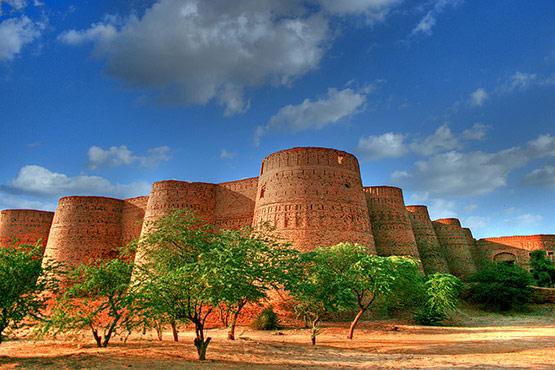
Cholistan is locally known as Rohi. This famous desert is 30 Km from Bahawalpur and comprises of an area of 16,000 sq.km. which extends upto the Thar desert extending over to Sindh. The word Cholistan is derived from ‘Cholna’ which means moving. The people of Cholistan lead a semi-nomadic life, moving from one place to another in search of water and fodder for their animals.
Culture and traditions
Local dialect
The local dialects spoken throughout Cholistan reflect a number of features from its historical and geographical background. In addition to their local dialect, members of most communities are able to converse fluently in Punjabi and Urdu, as both are far more easily and more widely understood.
Arts and crafts
In a harsh and barren land where rainfall is very sparse and unreliable, Cholistanis rely mainly on their livestock of sheep, goats, and camel. However in cold nights of winter they huddle indoor and engage themselves in various arts and crafts such as textiles, weaving, leatherwork, and pottery.
Local crafts
As mentioned above, the Indus Valley has always been occupied by the wandering nomadic tribes, who are fond of isolated areas, as such areas allow them to lead life free of foreign intrusion, enabling them to establish their own individual and unique cultures. Cholistan till the era of Mughal rule had also been isolated from outside influence. During the rule of Mughal Emperor Akbar, it became a proper productive unit. The entire area was ruled by a host of kings who securely guarded their frontiers. The rulers were the great patrons of art, and the various crafts underwent a simultaneous and parallel development, influencing each other. Masons, stone carvers, artisans, artists, and designers started rebuilding the old cities and new sites, and with that flourished new courts, paintings, weaving, and pottery. The fields of architecture, sculpture, terra cotta, and pottery developed greatly in this phase.
Livestock
The backbone of Cholistan economy is cattle breeding. It has the major importance for satisfying the area’s major needs for cottage industry as well as milk meat and fat. Because of the nomadic way of life the main wealth of the people are their cattle that are bred for sale, milked or shorn for their wool. Moreover, isolated as they were, they had to depend upon themselves for all their needs like food, clothing, and all the items of daily use. So all their crafts initially stemmed from necessity but later on they started exporting their goods to the other places as well. The estimated number of livestock in the desert areas is 1.6 million.
Cotton and wool products
Cholistan produces very superior type of carpet wool as compared to that produced in other parts of Pakistan. From this wool they knit beautiful carpets, rugs and other woolen items. This includes blankets, which is also a local necessity for the desert is not just a land of dust and heat, but winter nights here are very cold, usually below freezing points. Khes and pattu are also manufactured with wool or cotton. Khes is a form of blanket with a field of black white and pattu has a white ground base. Cholistanis now sell the wool for it brings maximum profit.
Textiles
It may be mentioned that cotton textiles have always been a hallmark of craft of Indus valley civilization. Various kinds of khaddar-cloth are made for local consumption, and fine khaddar bedclothes and coarse lungies are woven here. A beautiful cloth called Sufi is also woven of silk and cotton, or with cotton wrap and silk wool. Gargas are made with numerous patterns and color, having complicated embroidery, mirror, and patchwork. Ajrak is another specialty of Cholistan. It is a special and delicate printing technique on both sides of the cloth in indigo blue and red patterns covering the base cloth. Cotton turbans and shawls are also made here. Chunri is another form of dopattas, having innumerable colors and patterns like dots, squares, and circles on it.
Camel products
Camels are highly valued by the desert dwellers. Camels are not only useful for transportation and loading purposes, but its skin and wool are also quite worthwhile. Camel wool is spun and woven into beautiful woolen blankets known as falsies and into stylish and durable rugs. The camel’s leather is also utilized in making kuppies, goblets, and expensive lampshades.
Leatherwork
Leatherwork is another important local cottage industry due to the large number of livestock here. Other than the products mentioned above, Khusa (shoes) is a specialty of this area. Cholistani khusas are very famous for the quality of workmanship, variety, and richness of designs especially when stitched and embroidered with golden or brightly colored threads.
Jewelry
The Cholistanis are fond of jewelry, especially gold jewelry. The chief ornaments made and worn by them are Nath (nose gay), Katmala (necklace) Kangan (bracelet), and Pazeb (anklets). Gold and silver bangles are also a product of Cholistan. The locals similarly work in enamel, producing enamel buttons, earrings, bangles, and rings.
Love for colors
The great desert though considered to be colorless and drab, is not wholly devoid of color. Its green portion plays the role of “color belt” especially after rains when vegetation growth is at its peak. Adding to that the locals always wear brightly colored clothes mostly consisting of brilliant reds, blazing oranges shocking pinks, and startling yellows and greens. Even the cloth trappings of their bullocks and camels are richly colored and highly textured.
Forests in Cholistan
There is a rain forest in Cholistan named “Dodhla Forest”
Forts in Cholistan
Derawar Fort
Islamgarh Fort
Mirgarh Fort
Jamgarh Fort
Mojgarh Fort
Marot Fort
Phoolra Fort
Khangarh Fort
Khairgarh Fort
Nawankot Fort
Bijnot Fort
